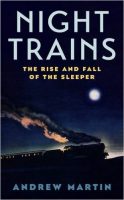Night Trains: The Rise and Fall of The Sleeper
by Andrew Martin
(Profile Books, £14.99)
 Andrew Martin is not easily discouraged. Setting out to write a lament for Europe’s international sleeper trains, he sees his first train cancelled, is robbed on another and wakes up in a third to find a stowaway in a grey hoodie leaning over his bed. Yet still he goes on — unlike the sleeper, which looks as though it’s about to disappear into permanent darkness. It’s being killed off by low-cost tourism and by high-speed trains, which are doing away with any need to have a bed on rails.
Andrew Martin is not easily discouraged. Setting out to write a lament for Europe’s international sleeper trains, he sees his first train cancelled, is robbed on another and wakes up in a third to find a stowaway in a grey hoodie leaning over his bed. Yet still he goes on — unlike the sleeper, which looks as though it’s about to disappear into permanent darkness. It’s being killed off by low-cost tourism and by high-speed trains, which are doing away with any need to have a bed on rails.
Night Trains is partly a history, a reminder of the days when trains such as the Orient Express promised passion, murder, revolution and intrigue — or at least a setting for them in the novels of Agatha Christie and Graham Greene. It’s also partly a travel book, recounting Martin’s attempts on modern-day trains (in 2015/16) to shadow the services of the Wagons-Lits company, whose glossy blue sleeper and dining cars swept across the Continent between the 1880s and the 1970s.
Maps would have helped the reader, just as a bit more integration in Europe would have helped the writer: on a journey from France through Switzerland to Italy, locomotives needed changing because each country requires a different in-cab safety system. Though aviation is 10 times more polluting than conventional rail, the EU and its predecessors have done more to encourage planes than trains.
The regular sleeper (as opposed to tourist services run by companies such as Belmond) is inherently uneconomic. Where it traverses one territory, it’s sometimes kept going for social and patriotic reasons; where it crosses international frontiers, it comes under the cold eyes of too many bean-counters. Deserted by the middle classes, it is, the author is told, now the province of students and sentimentalists.
Martin, in his early fifties, is mature for a student (he notes, tellingly, that the toothpaste he’s given in a toilet bag is “about the size of a tube of Airfix glue”) and, while an enthusiast for the railways, far from sentimental. He points out that his one-way journey in a three-berth compartment from Paris to Venice cost a total of £170 (including Eurostar ticket from London) — more than twice the price of a return flight to Venice.
The trains he take are ghosts of what they were. In the heyday of the Wagons-Lits he could have looked forward to the “musical tinkle” of crockery, cutlery and glass and to a nine-course spread on starched linen. Where he doesn’t have to bring on board his own food and drink, he’s handed shrink-wrapped snacks with shrink-wrapped plastic knives and forks.
He’s four journeys in before he has his first properly cooked dinner. On the Nordland Railway to the Arctic Circle, he enjoys both “the thrilling proximity of rail and sea”, which lasts for 100 miles along Trondheim Fjord, and a delicious pork stew called lapskaus, admittedly on a bendy paper plate. Elsewhere, provisions are thinner. At St Pölten in Austria, on the route of the old Orient Express, his breakfast cup of instant coffee comes with a jam-filled croissant in a sealed wrapper labelled “7 Days”. At one stage, his choice is “between the bleakness of the dining car… and the bleakness of my compartment”.
The book, then, succeeds better as a lament for what he and we have missed than for what we are about to lose. He declares, bravely, that even the journey on which he was robbed was memorable, which is more than he can say for his flight home on a no-frills airline. I’m with him on the superiority of trains. His wife will be harder to convince: while he was retracing the route of the old Sud Express from Paris through Spain to Lisbon, she flew, “having no interest whatsoever” in taking a sleeper. MK
This review appeared first in The Daily Telegraph
